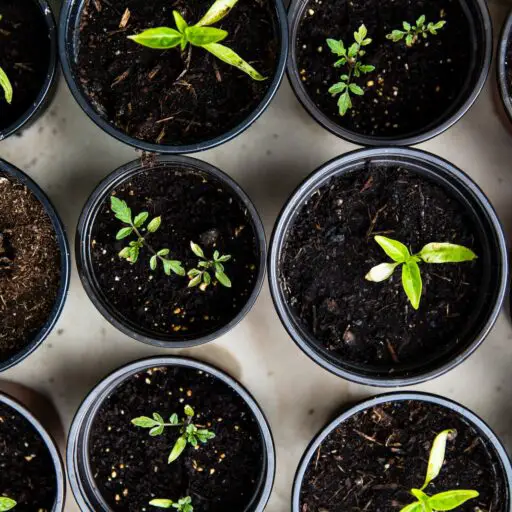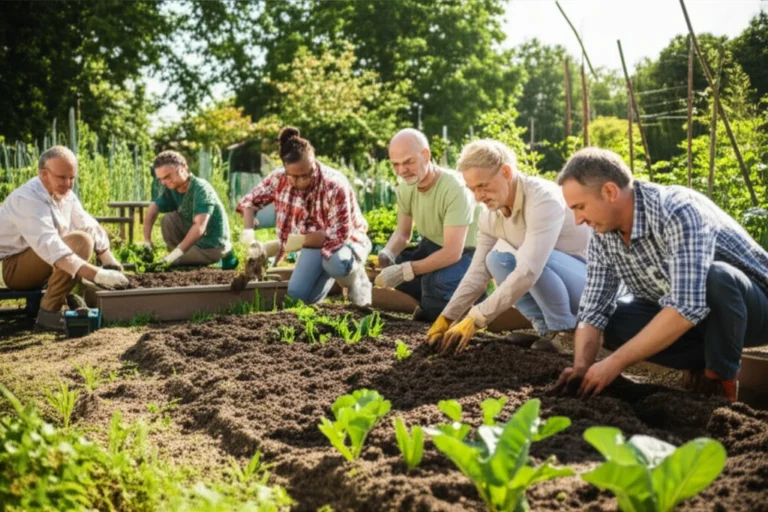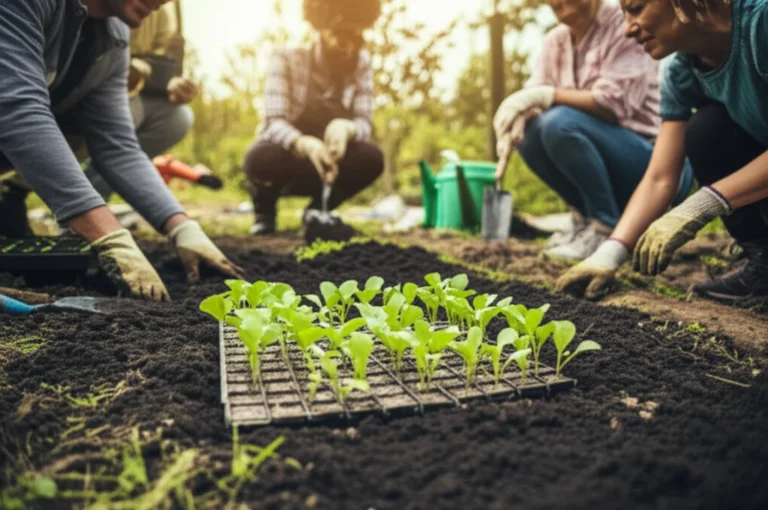Support our educational content for free when you purchase through links on our site. Learn more
Imagine a vacant lot in the heart of a bustling city transforming into a lush oasis bursting with fresh tomatoes, vibrant herbs, and buzzing pollinators. This isn’t just a pretty picture—it’s a powerful movement reshaping how communities worldwide tackle hunger and climate change. Community gardens are quietly revolutionizing global food security and sustainability, one plot at a time.
But how exactly do these green spaces nurture not only plants but also resilient communities and healthier ecosystems? In this article, we dig into 8 compelling ways community gardens promote local food access, empower neighborhoods, conserve resources, and foster environmental stewardship. Whether you’re a seasoned gardener or a curious newcomer, you’ll discover how these grassroots gardens are sprouting solutions to some of our planet’s biggest challenges—and how you can get involved.
Ready to unearth the secrets behind these urban farms of hope? Let’s get growing!
Key Takeaways
- Community gardens increase local access to fresh, nutritious food, especially in urban food deserts, improving food security and health outcomes.
- They empower communities by fostering food sovereignty, cultural preservation, and social cohesion.
- Gardens promote sustainable agriculture practices that conserve water, enrich soil, and support biodiversity.
- By reducing food waste and carbon footprints, community gardens contribute to climate resilience and environmental stewardship.
- Challenges like land access and funding exist, but innovative partnerships and policies are helping gardens thrive.
- You can support or start a community garden to make a tangible impact on your neighborhood and the planet.
👉 Shop Gardening Essentials:
- Fiskars Garden Tool Set: Amazon | Walmart | Fiskars Official Website
- Burpee Organic Seeds: Amazon | Burpee Official Website
- Espoma Organic Compost Starter: Amazon | Walmart | Espoma Official Website
Table of Contents
- ⚡️ Quick Tips and Facts
- The Roots of Resilience: A Brief History of Community Gardens and Their Evolution
- What Exactly Are Community Gardens, Anyway? 🌱
- Unearthing the Power: How Community Gardens Cultivate Global Food Security
- Sowing Seeds of Change: Community Gardens as Pillars of Sustainability
- Beyond the Garden Gate: The Broader Impact of Community Gardening Initiatives
- Navigating the Weeds: Common Challenges & Innovative Solutions for Garden Success 🚧
- From Local Plots to Global Impact: Scaling Up Community Garden Efforts 🌐
- Getting Your Hands Dirty: How YOU Can Get Involved in Community Gardening! 🙌
- Policy & Advocacy: Cultivating Supportive Environments for Community Gardens 🏛️
- Conclusion: The Future is Green, and It’s Growing in Our Communities! 🌟
- Recommended Links: Dig Deeper! 🔗
- FAQ: Your Burning Garden Questions, Answered! 🔥
- Reference Links: Our Garden of Knowledge 📖
⚡️ Quick Tips and Facts
Welcome to the green heart of the article! Before we dig deep, here are some quick, juicy facts from the Community Gardening™ team that’ll get your curiosity sprouting 🌱:
- Community gardens boost local food security by increasing access to fresh produce, especially in urban food deserts. USDA defines food deserts here.
- Gardeners tend to eat more fruits and veggies—a win for nutrition and health! (BMC Public Health, 2022) 🍅🥦
- These gardens reduce carbon footprints by cutting down food miles and food waste through composting.
- Community gardens build social bonds, fostering neighborhood cohesion and mental well-being.
- They serve as living classrooms, teaching sustainable agriculture, biodiversity, and climate resilience.
- Challenges include land access, funding, and long-term maintenance, but innovative solutions are sprouting everywhere.
- Scaling community gardens can amplify global sustainability efforts by empowering local food sovereignty.
For a deeper dive into the benefits of community gardens to the global community, check out our detailed article here.
Ready to dig into the roots of this movement? Let’s get growing!
The Roots of Resilience: A Brief History of Community Gardens and Their Evolution
Community gardens aren’t just trendy Instagram backdrops—they’re centuries-old grassroots solutions to food insecurity and urban blight. From the Victory Gardens of WWII to urban renewal projects in the 1970s, these green spaces have evolved into powerful hubs for sustainability and social justice.
- Early 20th century: Urban dwellers started reclaiming vacant lots to grow food during economic hardships.
- WWII Victory Gardens: Millions of Americans grew their own food to support the war effort, reducing pressure on commercial agriculture.
- 1970s-80s: Community gardens became tools for neighborhood empowerment and environmental activism.
- Today: They are recognized globally as key players in food security, climate action, and community health.
The New York State Community Gardens Task Force (2023) highlights how these gardens have become multi-functional spaces addressing food access, education, and ecological stewardship.
Want to see how history shapes today’s gardens? Keep reading!
What Exactly Are Community Gardens, Anyway? 🌱
Let’s clear the soil on definitions! A community garden is a shared space where individuals or groups grow fruits, vegetables, herbs, and flowers, usually on publicly accessible land. They differ from private gardens or commercial farms because their primary goals are social, educational, and environmental—not profit-driven.
Key characteristics:
- Open to local residents or community members.
- Managed collectively or by a nonprofit/municipality.
- Focus on food production, education, and community building.
- Often include composting, rainwater harvesting, and pollinator habitats.
For example, the GreenThumb program in NYC supports over 600 community gardens, showcasing how diverse and vibrant these spaces can be.
Community gardens are the living proof that food security and sustainability start at home — or better yet, in your neighborhood!
Unearthing the Power: How Community Gardens Cultivate Global Food Security
Community gardens are like little food fortresses, standing strong against hunger and insecurity. Here’s how they do it:
1. Boosting Local Food Access & Availability: From Plot to Plate! 🍎
- Fresh produce on demand: Community gardens provide fresh, affordable fruits and veggies right where people live, reducing dependence on distant supply chains.
- Food deserts no more: In urban areas where grocery stores are scarce, gardens fill the gap with nutrient-rich options.
- Season extension: Techniques like cold frames and hoop houses allow gardeners to grow longer, increasing year-round availability.
Real story: In Detroit, community gardens have transformed vacant lots into thriving food hubs, improving access for thousands.
2. Empowering Communities & Building Food Sovereignty: Growing More Than Just Veggies! 🤝
- Control over food sources: Community members decide what to grow, how to grow it, and who benefits.
- Cultural preservation: Gardens often include culturally significant crops, supporting identity and heritage.
- Collective decision-making: Shared governance fosters empowerment and resilience.
3. Enhancing Nutritional Well-being & Health Outcomes: A Rainbow on Your Plate! 🥕
- Studies show gardeners consume more fruits and vegetables than non-gardeners, improving diet quality and reducing chronic disease risks. (BMC Public Health, 2022)
- Access to fresh food encourages healthy cooking habits and reduces reliance on processed foods.
4. Fostering Economic Resilience & Livelihoods: Green Thumbs, Green Bucks! 💰
- Community gardens can reduce household food expenses.
- Some gardens sell surplus produce at local markets, generating income.
- Gardening skills can lead to job opportunities in horticulture, landscaping, or food entrepreneurship.
5. Cultivating Knowledge & Skills: The Classroom Without Walls 📚
- Gardens serve as hands-on education centers for sustainable agriculture, nutrition, and environmental stewardship.
- Youth programs teach lifelong skills and inspire future food leaders.
6. Strengthening Social Cohesion & Community Bonds: Where Neighbors Grow Together! 🤗
- Shared gardening fosters trust, cooperation, and social networks.
- Reduces social isolation and builds a sense of belonging.
- Encourages civic engagement and community pride.
7. Bridging the Digital Divide in Food Access: Tech-Enabled Growing! 📱
- Some gardens use apps and online platforms to coordinate planting, share resources, and educate gardeners.
- Digital tools help connect gardeners with markets and food assistance programs.
8. Addressing Food Deserts & Urban Hunger: Bringing Freshness to Forgotten Areas 🏙️
- Strategic placement of gardens in underserved neighborhoods combats urban food insecurity.
- Partnerships with local nonprofits and food banks amplify impact.
For more on the benefits of community gardens, explore our Benefits of Community Gardens section.
Sowing Seeds of Change: Community Gardens as Pillars of Sustainability
Community gardens don’t just feed people—they nurture the planet. Here’s how they champion sustainability:
1. Promoting Environmental Stewardship & Biodiversity: Nature’s Classroom 🦋
- Gardens create habitats for pollinators like bees and butterflies.
- Use of native plants supports local ecosystems.
- Organic practices reduce chemical inputs, protecting soil and water.
2. Conserving Precious Resources: Water, Soil, and Energy Smart! 💧
- Rainwater harvesting and drip irrigation minimize water waste.
- Composting enriches soil health, reducing fertilizer needs.
- Mulching conserves moisture and suppresses weeds.
3. Reducing Food Waste & Carbon Footprint: Composting Our Way to a Greener Future! ♻️
- Gardeners recycle organic waste into compost, closing nutrient loops.
- Local food production cuts down on transportation emissions.
- Waste reduction practices extend beyond the garden to households.
4. Building Climate Resilience: Adapting to a Changing World 🌍
- Diverse planting and crop rotation improve soil resilience.
- Shade trees and green spaces mitigate urban heat islands.
- Community gardens serve as emergency food sources during disruptions.
5. Supporting Pollinator Health: Buzzing Towards a Better Tomorrow 🐝
- Planting pollinator-friendly flowers boosts bee populations.
- Reducing pesticide use protects beneficial insects.
- Pollinators improve yields and biodiversity.
For inspiring garden design ideas that enhance sustainability, visit our Garden Design Ideas page.
Beyond the Garden Gate: The Broader Impact of Community Gardening Initiatives
Community gardens are more than dirt and seeds—they’re catalysts for change. Let’s explore the wider ripple effects:
Navigating the Weeds: Common Challenges & Innovative Solutions for Garden Success 🚧
Challenges:
- Securing long-term land tenure.
- Funding for tools, seeds, and infrastructure.
- Volunteer burnout and leadership turnover.
- Soil contamination in urban areas.
Solutions:
- Partnering with local governments and nonprofits for land access.
- Grant programs like the USDA Community Food Projects.
- Rotating leadership and community events to keep energy high.
- Soil testing and raised beds to avoid contamination.
From Local Plots to Global Impact: Scaling Up Community Garden Efforts 🌐
- Networks like the American Community Garden Association connect gardens nationwide.
- International programs promote urban agriculture for food security.
- Digital platforms enable knowledge sharing and resource pooling.
- Policy advocacy supports garden-friendly zoning and funding.
Getting Your Hands Dirty: How YOU Can Get Involved in Community Gardening! 🙌
- Find a local garden through community centers or platforms like LocalHarvest.
- Volunteer for planting, maintenance, or education programs.
- Start your own garden plot or organize a new community garden.
- Donate tools, seeds, or funds to support existing gardens.
Check out our Community Garden Events for upcoming opportunities near you!
Policy & Advocacy: Cultivating Supportive Environments for Community Gardens 🏛️
- Advocating for garden-friendly zoning laws and land use policies.
- Securing public funding and grants for garden infrastructure.
- Promoting inclusion and equity in garden access.
- Collaborating with schools, health departments, and urban planners.
Explore our Community Garden Policies for guidance on advocacy and governance.
Conclusion: The Future is Green, and It’s Growing in Our Communities!
Wow, what a journey through the vibrant world of community gardens! From their humble historical roots to their powerful role in promoting global food security and sustainability, community gardens are truly the unsung heroes of our neighborhoods. They don’t just grow food—they grow resilience, knowledge, social bonds, and hope.
We’ve seen how these green spaces:
- Provide fresh, nutritious food where it’s needed most.
- Empower communities to take control of their food systems.
- Foster environmental stewardship and combat climate change.
- Serve as hubs for education, social connection, and economic opportunity.
- Overcome challenges with creativity and community spirit.
If you’ve been wondering how you can help, remember: getting involved in a community garden is one of the most impactful ways to contribute to a sustainable future. Whether you plant a single seed or advocate for supportive policies, your efforts ripple outward.
So, ready to roll up your sleeves and join the movement? The soil is waiting, and the future tastes delicious! 🍅🌍
Recommended Links: Dig Deeper! 🔗
Looking to equip yourself or your community garden with the best tools and inspiration? Here are some top picks from our Community Gardening™ experts and trusted brands:
-
Gardening Tools & Supplies:
- Fiskars Garden Tool Set: Amazon | Walmart | Fiskars Official Website
- Burpee Organic Seeds Collection: Amazon | Burpee Official Website
- Espoma Organic Compost Starter: Amazon | Walmart | Espoma Official Website
-
Books on Community Gardening & Sustainability:
Dive into these resources to nurture your green thumb and community spirit!
FAQ: Your Burning Garden Questions, Answered! 🔥
What role do community gardens play in addressing food insecurity in urban areas?
Community gardens act as local food oases in urban food deserts, providing fresh fruits and vegetables where grocery stores may be scarce or unaffordable. By growing food locally, they reduce reliance on long, fragile supply chains and empower residents to produce their own nutritious meals. This direct access helps combat hunger and malnutrition, especially among vulnerable populations. Moreover, gardens often partner with food banks and social programs, amplifying their impact. According to the USDA and studies like those published in BMC Public Health, gardeners report higher food security and better diet quality.
How can community gardens contribute to sustainable agriculture and reduce environmental impact?
Community gardens promote organic, low-impact growing methods that conserve water, build healthy soil, and support biodiversity. Techniques such as composting, rainwater harvesting, crop rotation, and planting native species reduce chemical inputs and waste. By producing food close to consumers, they cut down on transportation emissions, lowering the carbon footprint. Gardens also create habitats for pollinators and mitigate urban heat islands, contributing to climate resilience. These practices align with principles of sustainable agriculture, making community gardens living laboratories for environmental stewardship.
What are the social benefits of community gardens, and how do they foster community engagement and cooperation?
Beyond food, community gardens are social glue that bring neighbors together across age, culture, and socioeconomic lines. Shared workspaces encourage collaboration, trust, and mutual support, reducing social isolation and fostering a sense of belonging. Gardens often host educational workshops, cultural events, and volunteer days, which boost civic participation and community pride. The social capital built in these spaces can ripple outwards, strengthening neighborhood safety and resilience. Studies have linked gardening participation to improved mental health and quality of life.
Can community gardens serve as a model for small-scale, locally-based food systems that promote global food security and sustainability?
Absolutely! Community gardens exemplify decentralized, community-controlled food systems that prioritize local needs, cultural relevance, and ecological balance. While they may not replace large-scale agriculture, they complement it by diversifying food sources, reducing waste, and building resilience against global disruptions like pandemics or climate shocks. Scaling up networks of community gardens and integrating them with urban agriculture initiatives can create robust, sustainable food webs that contribute meaningfully to global food security goals. The New York State Community Gardens Task Force Report (2023) underscores the potential of such models.
How do community gardens support environmental education and climate action?
Community gardens serve as hands-on classrooms where people of all ages learn about ecosystems, sustainable practices, and climate adaptation. They demonstrate techniques like permaculture, water conservation, and pollinator support in real time. By engaging communities directly, gardens inspire environmental stewardship and empower individuals to take climate action locally. This grassroots education complements formal programs and helps build a culture of sustainability.
What challenges do community gardens face, and how can they be overcome?
Common challenges include land tenure insecurity, funding shortages, volunteer burnout, and soil contamination. Solutions involve partnering with local governments for land leases, applying for grants (e.g., USDA Community Food Projects), rotating leadership roles to sustain engagement, and using raised beds or soil remediation techniques. Advocacy for supportive policies and community awareness campaigns also play crucial roles. The key is collaboration and adaptability.
Reference Links: Our Garden of Knowledge 📖
- United States Department of Agriculture (USDA) Food Access Research Atlas: https://www.ers.usda.gov/data-products/food-access-research-atlas/
- BMC Public Health Article on Community Gardens and Health Outcomes: https://bmcpublichealth.biomedcentral.com/articles/10.1186/s12889-022-13591-1
- New York State Community Gardens Task Force Report (2023): https://agriculture.ny.gov/community-gardens-task-force-2023-report
- American Community Garden Association: https://communitygarden.org/
- GreenThumb NYC Community Gardens Program: https://greenthumb.nycgovparks.org/
- LocalHarvest Community Gardens Directory: https://www.localharvest.org/
- Fiskars Official Website: https://www.fiskars.com/
- Burpee Seeds Official Website: https://www.burpee.com/
- Espoma Organic Gardening Products: https://www.espoma.com/
Ready to get your hands dirty and grow a greener, more secure world? We’re rooting for you! 🌿✨





